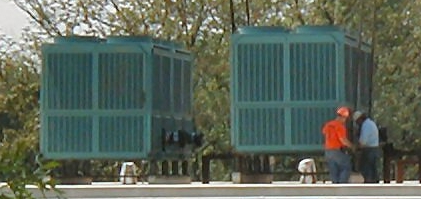Experiment of The Month
Followup on the Sound of Quality
The vibration, driven by air conditioning chillers, that was described earlier has been eliminated. The remedy involved two steps.
First, the chillers were moved to central part of the building where they could be supported more directly by the heavy vertical I-beam pillars that surround the building. These I-beams are less flexible and less likely to be driven into resonant vibration by perturbations from the chiller vibrations.
Second, the support directly under the three chillers was dramatically improved. In the original design, each chiller rested on springs coupled to a pair of short I-beams. These in turn rested on the roof-support beams, as shown in the photo by Shawn Reinfried below.

In the improved design has the chillers mounted on a small I-beam frame. This frame sits on springs which rest on a heavy I-beam frame. The heavy frame sits on the vertical building columns. The frames are visible in Shawn Reinfried's photo below, at the bottom of the picture.

A close-up of the frames is shown below. The tops of two building columns are visible at the right and left corners of the large frame. A close look reveals the springs connecting the small frame to the large frame, and two men adjusting the tension on the springs.

The virtue of the massive and stiff large frame is not that it refuses to vibrate in response to the chillers. Rather, it is that the amplitude of vibration will be small because the mass is so large. In turn, this small amplitude vibration of the frame will drive only a small amplitude vibration in the rest of the building. (Technically, there is a large acoustic impedance mismatch between the two frames, so the junction between them transmits very little vibrational energy.)
Finally, the vibrations are coupled into compression (rather than bending) of the vertical pillars. The pillars are much more resistant to compressive deformation than they are to bending deformation.
The vibrations are now (of course) gone from the wing of Caputo Hall which formerly supported the chillers. The good news is that they did not reappear in the wing which now supports the chillers. The combination of spring mounting, inertial vibration barrier, and compressive loading has been successful.
Informal conversations indicate that our ability to measure the vibration amplitude of a concrete floor that was caused by the old chiller mount helped to bring about this improvement.
-
Contact Information
Contact Number: 717-871-4297
Email: physics@millersville.edu